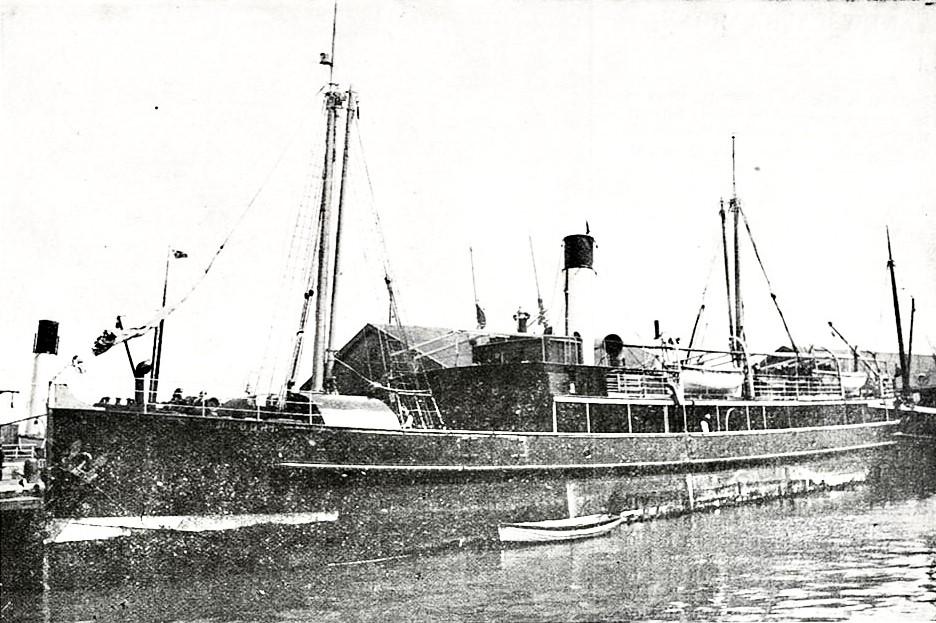Sands of time by John Lawson – Continuing our occasional history series, we look back to Whāingaroa a century ago – 1923
The steamers continued their weekly link with Onehunga. Rimu (412 tons), the usual steamer serving Raglan and Kawhia, was in for repair at the start of the year, so Arapawa (291 tons) was covering the run, until Aupouri (463 tons) took over in March. Aupouri also took the annual fishing excursion to Karewa – Gannet Island. As usual there were several reports of the steamers being delayed by storms. Their cargoes included butter and wool. Council was asked to reduce charges at the wharf to offset road competition, but didn’t. Sheep numbers were increasing, the returns for Raglan county being 1922 – 162,783, 1923 – 168,264, 1924 – 213,446. Other crops mentioned were oats, swedes and plums.
AUPOURI. WHICH ARRIVED IN AUCKLAND HARBOUR FROM GLASGOW ON DECEMBER 15, 1905.
IT TOOK OVER THE WEEKLY SERVICE TO RAGLAN IN 1923.
The Aupouri was a twin-screw steel vessel, about 460 tons, and was built by Messrs. D. J. Dunlop and Co., of Port Glasgow.
Work started on Te Uku Post Office and telephone exchange on 4 October, when the Chief Postmaster drove a peg in the ground, though the office didn’t open until 1927. It is now the Roast Office.
Social activities were numerous. Raglan Bowling Club agreed to admit ladies as members in 1923. There were also tennis clubs at Te Uku, Okete, Te Mata and Waitetuna and Raglan, Te Uku and Okete Hockey Clubs and other activities included Raglan Horticultural Society, Raglan A. and P. Winter Show, Raglan Rugby Football Club, Te Mata Equestrian Sports, Raglan Carnival Club, Karioi Gun Club, euchre and 500 parties, dances and balls, often well into the early hours despite the lack of electric light, ping-pong, a model yacht race, garden fete, school picnics and a farewell to Mr G. G. Griffiths, the out-going editor of the Raglan Chronicle. Music was provided on the accordion, violin and piano and from Raglan Orchestra and Raglan Town Band. A Māori group from Whatawhata performed a Moarue Nu-Akwa concert in Te Mata Hall, though the lorry bringing them broke down and they started late. Hamilton Acclimatisation Society liberated more pheasants in the Raglan, Waitetuna, Te Uku area. Rabbits were also increasing, “at an enormous rate”.
Ruakiwi school moved into a new corrugated iron building in November. Raglan school was fundraising for a piano and for gramophone records. They listened to the King’s message to the school children of New Zealand, with a powerful gramophone. It was proposed to raise £60 to put a fence around the Bow St war memorial.
In May’s local elections only two ridings were contested:— Karioi was won by Charles Swann with 98 votes to G. Vernon’s 71 and, in Whaingaroa Riding, Thomas Parker, with 84, narrowly won over C. W. Ralfe, 71 and W. J. Lusty 70. A July Raglan Town Board by-election was won by Noel Robertson by 75, to Charles Ralfe’s 42.
Raglan Town Board got approval (100:18) in a poll of the ratepayers to spend £4,150 forming, metalling, kerbing, channelling, tarring and sanding roads and footpaths, and £500 to build an office and library. They also decided to build a public rest room.
A lifeboat from the former training ship Amokura was donated to Raglan Sea Scouts and restored as an up-to-date lifeboat. Also, Frankton Boy Scouts came by lorry to camp on Greenslade Rd at, “Black Rock —just beyond the Dough Boys, some two miles from Raglan town. A shallow valley, heavily timbered with giant titree, down which a miniature stream threads its way—a triangular strip of grassy sward, and a tumbled mass of black volcanic rock on the shore.”
In 1923 the Raglan Town Board talked to the Central Waikato Electric Power Board about linking power lines from Whatawhata, or joining the Bryant House hydro electric scheme. However, the engineer said line construction over the mountain would require felling a considerable amount of bush and returns would not warrant it. It wasn’t until 1935 that Raglan got mains power.
Changes were becoming more apparent; the population was to roughly triple over the next three decades, reflecting the easier accessibility.
